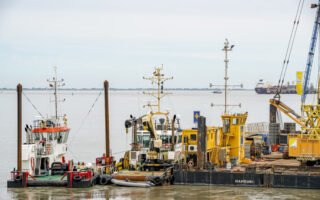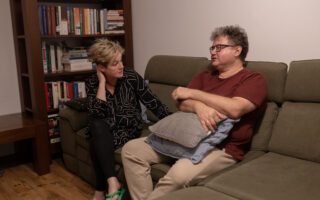D-Day at 80

They were ordinary. The young men from afar who clambered ashore on June 6, 1944, into a hail of Nazi gunfire from the Normandy bluffs did not think of themselves as heroes.
No, said Gen. Darryl A. Williams, the commanding general of United States Army Europe and Africa, the allied soldiers “in this great battle were ordinary,” youths who “rose to this challenge with courage and a tremendous will to win, for freedom.”
In front of the general, during a ceremony this week at Deauville on the Normandy coast, were 48 American survivors of that day, the youngest of them 98, most of them 100 years old or more. The veterans sat in wheelchairs. They saluted, briskly enough. Eight decades have gone by, many of them passed in silence because memories of the war were too terrible to relate.
When the 90th anniversary of D-Day comes around in 2034, there may be no more vets. Living memory of the beaches of their sacrifice will be no more.
“Dark clouds of war in Europe are forming,” Williams said, as he alluded to allied determination to defend Ukraine against Russian attack. This 80th anniversary of the landings is a celebration, but a somber one. Europe is troubled and apprehensive, extremism eating at its liberal democracies.
For more than 27 months now, there has been a war on the Continent that has taken hundreds of thousands of young Ukrainian and Russian lives. Russia was not invited to the commemoration even though the role of the Soviet Red Army in the defeat of Hitler was critical. A decade ago, President Vladimir Putin attended. Now he speaks of nuclear war. It is a time of fissuring and uncertainty.
Every one of the long-lived veterans who returned to Normandy knows where such drift can lead, how easy it is to sleepwalk toward conflagration.
“It’s between you and the higher-up,” said George K. Mullins, 99, a former staff sergeant in the 327th Glider Infantry Regiment of the 101st Airborne, as he recalled the day he came ashore at Utah Beach with a folding carbine hooked to his belt and two K-rations. “We know there’s a spirit somewhere.”
D-Day was not an end but a beginning. The Normandy campaign, zigzagging through the hedgerows that still divide fields today and teem in the sunlight with insect life, took a terrible toll.
Mullins, who now lives in Garberville, California, looked up from his foxhole a couple of days into the fighting and, two foxholes away, saw Pfc. William H. Lemaster, peeking over the edge. It proved to be the last act of this young man from West Virginia.
A German sniper’s bullet cut through Lemaster’s head and killed him – a memory so vivid that Mullins took a moment this week to kneel at his buddy’s grave in the American Cemetery in Colleville-sur-Mer.
There are 9,388 graves in the cemetery, most of them in the form of white Latin crosses, a handful of them Stars of David commemorating Jewish American service members. As antisemitism rises again in Europe, they seem somehow more conspicuous.
The allied army did not advance to save the Jews of Europe – suggestions that the railroads to Auschwitz be bombed were rejected. But the end of the war in Europe 11 months after D-Day did bring an end to Hitler’s slaughter of 6 million Jews.
Today, in Germany, Maximilian Krah, the top candidate for the extreme-right Alternative for Germany party in elections this weekend for the European Parliament, asserts that not all members of the Waffen SS, the Nazi paramilitary group, were criminals. Another AfD leader, Björn Höcke, was convicted last month of using a Nazi slogan.
“A far-right party that wears its historical revisionism on its sleeve has up to 20% support in polls,” said Jan-Werner Mueller, a politics professor at Princeton University. “I never thought I would see this in my lifetime. There seems to be no limit on how far the extreme right will go.”
History may not repeat itself but it does rhyme, as Mark Twain is said to have noted.
Here in Normandy, the thousands who died as the Allies secured a toehold in Europe are everywhere, their black-and-white photographs attached to wooden utility poles on the Road of the 1st (American) Division that leads from Colleville-sur-Mer down to Omaha Beach. In their youthful expressions, innocence and hope predominate. Roland Barthes, the French essayist, observed that in every old photograph lurks catastrophe.
Perhaps the world, just two years after the end of the Covid-19 pandemic, needs little reminder of what it is like to be swept away by the gale of history, what it is for every assumption to collapse, what it is to feel the extreme fragility of freedom and life. Certainly, with armed conflicts raging in Ukraine and the Gaza Strip, it needs no reminder of war’s perennial grip on humanity.
Hatred gets the blood pumping in a way that reasoned compromise and civilized disagreement – foundations of any healthy society living in freedom under the rule of law – do not. Today, many politicians in Western societies do not hesitate to play on such emotions in attacking “the other.”
Patrick Thomines, the mayor of Colleville-sur-Mer, stood in front of a school bedecked with the French, American and European Union flags, symbolizing the postwar trans-Atlantic foundation of the West. “You realize that peace is never won for all time, it’s an eternal struggle to secure it,” he said. “We should unite to avoid war, but extreme parties are rising and represent the very contrary of what we are celebrating here.”
The celebration has an extraordinary magnetism. The horrifying cratered landscape at the Pointe du Hoc, reminiscent of the still-pitted terrain of the Battle of Verdun in World War I, poses and reposes the question of how U.S. Rangers scaled that cliff. People flock to see it and wonder.
Converging from countless countries, they join in uniformed reenactment groups. They careen around among the hedgerows in jeeps, provoking endless traffic jams. They party and they dance and they come together on the vast wide sandy beaches in solemn contemplation of how Europe was saved from Hitler. Their children go to museums that recreate the terrain and the battle.
Yuri Milavc, a Slovenian who had traveled from Ljubljana with a jeep, along with 18 friends, also in jeeps, said he had now come to the Normandy commemorations several times. The feeling today was more mixed, he said. “I remember how Europe once felt,” he told me. “Now Putin has showed his true colors and is fighting the last imperialist war in Europe.”
President Joe Biden will meet with Volodymyr Zelenskyy, the president of Ukraine, in Normandy this week, a show of allied support for the country at a time when it is under increased Russian attack. French President Emmanuel Macron, who has invited Biden to a state dinner Saturday, has also chosen to draw a strong link between the 80th anniversary of D-Day and the fight for freedom in Ukraine.
“I know that our country, with its bold and valiant youth, is ready in the same spirit of sacrifice as our forbears,” he said in a speech Wednesday in Brittany.
When it comes to spirit, it is difficult to match that of Cpl. Wilbur Jack Myers, 100, of Company B, 692nd Tank Destroyer Battalion, attached to the 104th and 42nd Infantry Division. He was so excited about coming to Normandy for the anniversary, he said he did not “feel a day over 85!” To prove it, he’s been enjoying karaoke sessions back home in Hagerstown, Maryland.
One of 13 children from a Maryland family, trained to be a gunner, Myers arrived in Cherbourg, France, on September 23, 1944. It was the start of an odyssey that ended with the liberation of the Nazi Dachau camp near Munich in late April 1945.
“It really hurt me to look at those skin-and-bone prisoners, and I knew that many were already dead,” Myers told me. “I’ve never forgotten it, but for 50 years I was silent because if I tried to talk about the war I would tear up and get embarrassed. Finally, I got the strength.”
Myers said he felt he had to be part of the fight to stop Hitler, but had no wish to die. He was a gunner with a 90-mm anti-tank gun, a “helluva weapon,” as he put it. One devastating firefight in which a member of his tank crew died as shrapnel went through his steel helmet took a heavy emotional toll. The dead man was a Native American named Albert Haske.
“Recently his great-great-great nephew saw me on TV and made contact with me,” Myers said. “Looks just like his uncle!”
Sometimes he would examine German corpses and find crucifixes and conclude that despite their faith they could not say no to Hitler. His own Christian faith is strong. He said it keeps him walking straight and loving others and that is how he has made it this far. Hatred, he believes, is part of human nature, and the quest for power and money provokes wars, but all this can be beaten with faith. “Hell, I don’t even know you and I love you!” Myers said.
He grew meditative about war. “You know, I never killed anyone I did not have to, although I felt like it a lot of times when we were pinned down. It’s hard for me to believe that today Putin is so ready to kill to seize other countries.”
With war back in Europe, the ghosts that have haunted the Continent feel closer, when two decades ago it appeared they had been laid to rest. The European Union was created to put an end to war and has proved a peace magnet. NATO has been Europe’s military guarantor. The two institutions have held the line, but the line between the world and war feels flimsier today than in a long time.
It has been hard to escape that feeling even in a festive Normandy. and I have found myself thinking of the last verse of Siegfried Sassoon’s “Suicide in the Trenches,” a poem of World War I:
You smug-faced crowds with kindling eye
Who cheer when soldier lads march by,
Sneak home and pray you’ll never know
The hell where youth and laughter go.
This article originally appeared in The New York Times.






